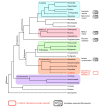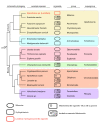Anaerobic animals from an ancient, anoxic ecological niche
- PMID: 20370917
- PMCID: PMC2859860
- DOI: 10.1186/1741-7007-8-32
Anaerobic animals from an ancient, anoxic ecological niche
Abstract
Tiny marine animals that complete their life cycle in the total absence of light and oxygen are reported by Roberto Danovaro and colleagues in this issue of BMC Biology. These fascinating animals are new members of the phylum Loricifera and possess mitochondria that in electron micrographs look very much like hydrogenosomes, the H2-producing mitochondria found among several unicellular eukaryotic lineages. The discovery of metazoan life in a permanently anoxic and sulphidic environment provides a glimpse of what a good part of Earth's past ecology might have been like in 'Canfield oceans', before the rise of deep marine oxygen levels and the appearance of the first large animals in the fossil record roughly 550-600 million years ago. The findings underscore the evolutionary significance of anaerobic deep sea environments and the anaerobic lifestyle among mitochondrion-bearing cells. They also testify that a fuller understanding of eukaryotic and metazoan evolution will come from the study of modern anoxic and hypoxic habitats.
Figures


Comment on
-
The first metazoa living in permanently anoxic conditions.BMC Biol. 2010 Apr 6;8:30. doi: 10.1186/1741-7007-8-30. BMC Biol. 2010. PMID: 20370908 Free PMC article.
References
-
- Yakimov MM, La Cono V, Denaro R, D'Auria G, Decembrini F, Timmis KN, Golyshin PN, Giuliano L. Primary producing prokaryotic communities of brine, interface and seawater above the halocline of deep anoxic lake L'Atalante, Eastern Mediterranean Sea. ISME J. 2007;1:743–755. doi: 10.1038/ismej.2007.83. - DOI - PubMed
Publication types
MeSH terms
Substances
LinkOut - more resources
Full Text Sources
Miscellaneous

